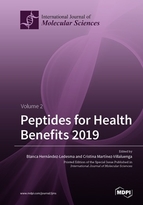Peptides for Health Benefits 2019
A special issue of International Journal of Molecular Sciences (ISSN 1422-0067). This special issue belongs to the section "Bioactives and Nutraceuticals".
Deadline for manuscript submissions: closed (30 November 2019) | Viewed by 197855
Special Issue Editors
Interests: bioactive peptides; food proteins; multifuncionality; digestion; bioavailability; inflammation-associated diseases; chemopreventive activity; peptidomics; antioxidant activity
Special Issues, Collections and Topics in MDPI journals
Interests: grains; peptides; phenolic compounds; nutritional characterization; protein quality and digestibility; bioavailability of food compounds; bioactivity; germination; fermentation; enzymatic treatments
Special Issues, Collections and Topics in MDPI journals
Special Issue Information
Dear Colleagues,
In recent years, peptides have received increased interest by the pharmaceutical industry. The high potency, specificity and good safety profile are the main strengths of bioactive peptides as new and promising therapies that may fill the gap between small molecules and protein drugs. These positive attributes of peptides, along with advances in drug delivery technologies, have afforded a renewed interest in the discovery, optimization and development of peptides as pharmacological therapy. Among bioactive peptides, those released from food protein sources have acquired importance as nutraceutical and active components in functional foods because they are known to possess regulatory functions that can lead to health benefits.
This Special Issue, “Peptides for Health Benefits”, will cover a selection of recent research papers, reviews, short communications, as well as perspectives in the field of bioactive peptides. It aims to cover all aspects of peptide research in relation to health promotion. In particular, this Special Issue emphasizes current knowledge and research trends concerning bioactive peptides, including identification and quantification of peptides from new sources, methods for their production and purification, structure-function relationships, mechanisms of action, development of novel in vitro and in vivo assays for the evaluation of their bioactivity, physiological evidence to support health benefits, and peptide stability, bioavailability, and sensory (or techno-functional) properties. Papers regarding the development of new drugs, functional foods or nutraceuticals based on bioactive peptides will be also taken into consideration.
Dr. Blanca Hernández-Ledesma
Dr. Cristina Martínez-Villaluenga
Guest Editors
Manuscript Submission Information
Manuscripts should be submitted online at www.mdpi.com by registering and logging in to this website. Once you are registered, click here to go to the submission form. Manuscripts can be submitted until the deadline. All submissions that pass pre-check are peer-reviewed. Accepted papers will be published continuously in the journal (as soon as accepted) and will be listed together on the special issue website. Research articles, review articles as well as short communications are invited. For planned papers, a title and short abstract (about 100 words) can be sent to the Editorial Office for announcement on this website.
Submitted manuscripts should not have been published previously, nor be under consideration for publication elsewhere (except conference proceedings papers). All manuscripts are thoroughly refereed through a single-blind peer-review process. A guide for authors and other relevant information for submission of manuscripts is available on the Instructions for Authors page. International Journal of Molecular Sciences is an international peer-reviewed open access semimonthly journal published by MDPI.
Please visit the Instructions for Authors page before submitting a manuscript. There is an Article Processing Charge (APC) for publication in this open access journal. For details about the APC please see here. Submitted papers should be well formatted and use good English. Authors may use MDPI's English editing service prior to publication or during author revisions.
Keywords
- Human health
- Bioactive peptides
- Food peptides
- Biological activity
- Peptidomics
- In vitro and in vivo assays
- Identification and characterization
- Functional foods
- Peptide-based therapies
Related Special Issues
- Peptides for Health Benefits in International Journal of Molecular Sciences (13 articles)
- Peptides for Health Benefits 2020 in International Journal of Molecular Sciences (31 articles)
- Peptides for Health Benefits 2021 in International Journal of Molecular Sciences (18 articles)
- Peptides for Health Benefits 2023 in International Journal of Molecular Sciences (2 articles)








